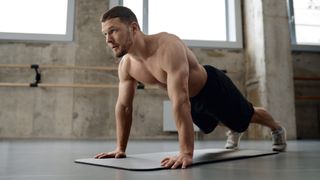
Take these three bodyweight exercises and give your chest, shoulders, triceps and core a blast without machines, the best adjustable dumbbells, kettlebells, or barbells.
There are plenty of ways to strengthen your upper body muscles without weights, and we've plucked three bodyweight exercises that sit under the “calisthenics” umbrella to create a mean chest and tri's workout fit for any beginner or experienced exerciser.
You can access these moves anywhere, anytime, and you only need your body weight to do so. So if you want to put your muscles through the wringer, add this bodyweight session to your existing strength programs, either as a one off or a regular addition to mix things up.

It’s worth mentioning that packing on lean muscle mass and sculpting a strong torso requires learning how to progress your routine and keep challenging your muscles progressively over time.
Bodyweight exercise is a type of functional training and is brilliantly effective if you want to develop functional strength and improve the quality of your daily movement. Your muscles, bones and joints can all benefit from learning to move with your body weight alone, using natural movement patterns. And it's the best way to prepare yourself for lifting weights.
This type of workout also works well for beginners looking to build foundational strength and muscle before diving into the world of weightlifting. So, whatever your reason for ditching the weights in favor of your body weight, there are benefits to be found.
What is the 3-move bodyweight workout?
You only need three exercises and 28 minutes to complete this workout. If you decide to add weights, we recommend the best kettlebells for weightlifting or dumbbells if you prefer, but you won’t need them to torch your pecs and arm muscles.
Sign up to get the BEST of Tom’s Guide direct to your inbox.
Upgrade your life with a daily dose of the biggest tech news, lifestyle hacks and our curated analysis. Be the first to know about cutting-edge gadgets and the hottest deals.
Watch the videos to learn how to do each exercise with proper form.
Every 7:00 minutes for 4 sets:
20 x Burpees
30 x Spiderman planks
40 x Deficit push-ups
Perform 20 burpees, then move straight to 30 Spiderman planks and finish with 40 deficit push-ups. You have seven minutes to complete the round. Rest for the remainder of the time, then repeat for a total of four rounds.
Burpees
Aim for chest-to-floor burpees, but modify by stepping or jumping back if you prefer. Keep your core engaged and lift your upper body as one unit without dropping your hips. Keep the burpees consistent and find a pace you can maintain, completing your reps in no more than two sets (10 reps per set).
Here’s how to do a burpee in more detail.
Spiderman planks
It’s one of the best plank variations around. Keep your core engaged and draw your knee toward your elbow with control, with your hips square to the mat. You can choose a forearm position or straight-arm plank. Either option will engage your obliques — the muscles that run down your waist — to achieve a gentle crunch as you move. Switch sides every rep, completing 30 reps in total. Increase the speed to prioritize cardio or slow it down to work the muscles for longer and test core stability.
Deficit push-ups
The bench press isn’t the only way to blast your chest, shoulders and arms. Deficit push-ups increase your range of motion and allow muscles to work through a fuller range. You could use blocks, push-up bars, or weights to elevate your hands and lower your chest to the floor. Keep your hips lifted and control the eccentric motion (lowering toward the floor) while explosively pushing up during the concentric phase (the push-up). If you need an extra burn, add a small pulse at the bottom of the exercise.
Bottom line
A common misconception is that you can’t make muscle gains or build strength using bodyweight exercises. False. Although weight training allows you to increase the load gradually, you can also adapt variables like rest-work timing, tempo, sets and reps to make exercises harder.
This 28-minute upper body workout minimizes rest and uses high rep ranges against the clock to keep your muscles under constant tension and load. How much rest you earn is up to you based on how long it takes to complete the exercises.
After the first round, decide whether to increase or decrease your rep ranges. If you’re getting less than 30 seconds of rest, decrease reps. If you finish too early (two minutes or more), increase reps.
And if you want to use the format again with different exercises, we recommend the 7 best dumbbell shoulder exercises for your upper body. Remember to schedule rest to allow muscles to recover from the stressors of exercising, and prioritize good quality protein intake to help scale up muscle growth during recovery.
More from Tom's Guide

Sam Hopes is a level III qualified fitness trainer, level II reiki practitioner, and senior fitness writer at Future PLC, the publisher of Tom's Guide. She is also about to undertake her Yoga For Athletes training course. Having trained to work with mind and body, Sam is a big advocate of using mindfulness techniques in sport and fitness, and their impact on performance. She’s also passionate about the fundamentals of training and building sustainable training methods. When she's not writing up her experiences with the latest fitness tech and workouts, you’ll find her writing about nutrition, sleep, recovery, and wellness.
